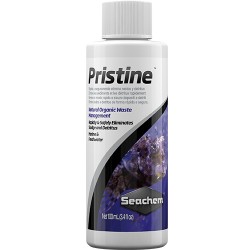Salifert Profi Test Magnesium
Magnesium, in nature, is present in marine water in a fairly high concentration (1300-1400 mg/l)
Magnesium is an essential part of chlorophyll, which is necessary for photosynthesis. Photosynthesis also the algae and corals, which we keep in our tanks, could not survive. Magnesium has another important function because it makes it possible to maintain a correct combination between calcium concentration and alkalinity (or carbonate hardness). Calcium, in fact, forms with carbonates and bicarbonates an insoluble compound called calcium carbonate. Calcium is a fundamental element for corals and limestone algae, but should result from biological processes and be deposited in the right place. Therefore the formation of calcium carbonate through chemical processes should be avoided. Even in the absence of biological interference could form calcium carbonate and this could lower calcium concentration and alkalinity without fulfilling any positive function. This process depreciates many trace elements necessary for aquarium health. The Magnesium slows down this negative process. The lower the magnesium concentration, the faster this negative phenomenon takes place. Maintaining a correct concentration of Magnesium is more important and indirectly reflected on the growth of your corals (thanks to the possibility of maintaining calcium and alcalinity as stable as possible) Magnesium is decreased by algae, by the excessive use of Kalkwasser and by the removal of natural values of calcium, ph and alkalinity. There are also some salt brands that have a dramatically low magnesium content. Using them means running into permanent problems with calcium concentration and alkalinity values.
The measurement of magnesium is of fundamental importance. Magnesium is an element whose role has been underestimated for too long. The magnesium content of many aquariums, when tested, is inadequate. The Magnesium salifert test is extremely clear and does not suffer the influences of calcium and strontium. Measure intervals of 30 mg/l with a very precise color scale.
a) Take, with the appropriate syringe, 2 ml of water to analyze and place them in the transparent container.
b) Add to the water taken 4 drops of Mg-1 liquid, close the container with the blue cap and gently shake for 30 seconds
c) Add a satin teaspoon (blue) of Mg-2 and stop and shake for 10 seconds
d) Fill the syringe with the Mg-3 liquid.
refer to the upper part of the black syringe ring, do not worry about the presence of air
e) Add three drop to drop the Mg-3 in the container until the color of the compound in it changes from gray to blue.
Remember to shake, at each drop, 1 or 2 seconds
f) Handle the syringe with the tip upwards and read the Mg-3 level remaining at the black syringe ring.
e)Confrontate this value with those shown in the table and you will have the magnesium concentration in the tub.
















